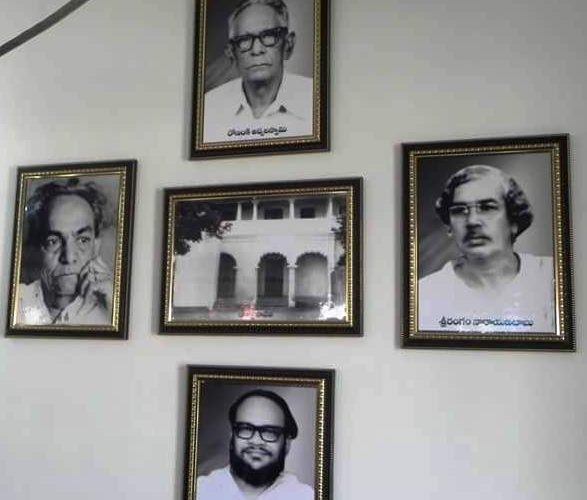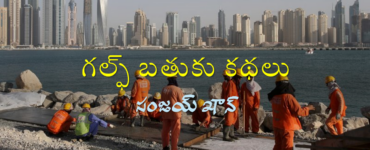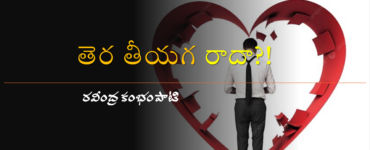The members of the VQC are Purinapda Appala Swami, Ronanki Appala Swami, Srirangam Narayana Babu, Srirangam Srinivasa Rao (Sri Sri) , Chaganti Somayajulu ( Chaso) and Arudra. While Puripanda was the eldest of the lot (Born 1901), Arudra was the youngest born (1925). Ronanki, Narayana babu, Sri Sri, and Chaso, were in that age order chronologically.
The letters were addressed to Chaganti Somayajulu, Kaspa, Vizianagaram, wherein at Chinnapalli Street there was a Chaganti Haveli, the ancestral residence of Chaso. The VQC members had a vigorous exchange of ideas, agreements, heated arguments over the trends and themes of modern world literature, and this foundation at their grooming age, and at a time of writing in their forceful expression, left the Chaso Haveli enshrined in the history of modern 20th century Telugu literature, as the most happening place, which hallowed importance still enjoyed by the Vizianagaram fort being the first place of modernity, signified in 1890s, with the tour de force of Gurajada, the vernacular play Kanyasulkam, making a bang of an entry, in 1892, into a dull and monotonous world of the then Telugu literature.
Thus Gurajada’s period is taken as the fist phase of modernity, and from the very place, it is not without reason the second phase of modernity too had started in 1930-40 period. This time not one or two, but half a dozen enthusiasts of modernity, and students of historic currents of the world, marched ahead, every one of them a flag bearer of Gurajada’s progressive liberalism, scientific vision, and an egalitarian dream that the world will become an equal opportunities place to all the citizens and it is the duty of the writers to advocate it’s cause.
The VQC had its most vocal votary in Srirangam Narayana Babu, who sang and danced to the rhymes of world poetry, which were rendered in English, German and French by the polyglot Pandit Ronanki Appala Swami. Puripanda had brought in the flavor from Eastern languages of Bengali, Odiya, and of course Hindi. Sri Sri and Narayana Babu, reflected the discourses and exchanges into sharp poetry leading the pack, while Chaso carved many thoughts into gems of stories.
Ronanki never wrote any in Telugu, and remained a contented reader and an avid student of world literature, and played the role of World Radio, to the benefit of the members of the VQC. Arudra, who joined in the later days, grew to be an experimenting poet with form and content and developed into a major poet and literary historian as well.

Around 1940s, Narayana Babu, Sri Sri and Arudra left to other places in pursuit of eking out livelihood and making careers, and most of the letters they wrote to Chaganti Somayajulu, form the bulk of this compendium. Since in 1936, the Progresive Writers s Association started in Lucknow, with the national talent of literature endorsing the broad progressive ideas including Pandit Jawahalrla Nehru, this forward looking dynamism took some years to reach Telugu region.
In 1942, the Abhyudaya Rachayitala Sangham(ARASAM) was formed at Tenali, with the background work done by Chadalavada Pichayya, Chaso and Setti Eswara Rao. The first meeting took place under the president ship of Tapi Dharmarao, by then a champion of modernity in all walks of life. The letters exchanged among the VQC members away from Vizianagaram indicate their mind about this emerging consolidation of writers.
The letters between the VQC for the first time give out a glimpse of the labor pains of birth of ARASAM, the importance of literary movements like Surrealism, to which Narayana Babu remained an ardent follower, and as late as 1960, when he was writing a foreword to “Sangharshana”, a poetry anthology by Rentala Gopala Krishna, he explained at length what is “Noveau” movement in Telugu literature as well.
The letters also for the first time, provide graphologists a feast of opportunity to look at the hand writing of stalwarts of literature like, Narayana Babu, Jalasootram Rukminanatha sastry, Krishna Sastry, Sri Sri, Chaso, Chadalavada Pichayya, Vajhala China Sitaraama Swami, Arudra, C.Narayanareddy, Avasarala Surya Rao, Puranam Subrahmanya Samra, K.V.Ramana Reddy, Jwalamukhi, Manepalli Satyanarayana, Somasundar, Vara Vara Rao and some others.
Though some of the issues and debates were dealt at length and available elsewhere on record as essays , rejoinders and comments, here for the first time, in the sheaf of letters, presented well in scanned copies of originals, and carefully typeset in Telugu and English, the production is in international spirit and style, in presenting a period document, with all its specialties preserved intact.
The controversies around Sri Sri and Narayana Babu’ s importance in literature, perceived personally by Sri Sri, and in a spirited friendly obligation to the latter, by the rest of the VQC, particularly when the poetry of Narayana Babu ( dedicated to the now differing Sri Sri long back by Narayana Babu, (who is a brother in relation to Sri Sri) is being readied posthumously for publication and comments exchanged in the letters, and standpoints taken demonstrate to a point, a side wing view to the unseemly controversy, and thanks to Dr. Tualsi, now allows the readers, a conclusion of their own.
The letters exchanges between the members of VQC, and in general from others, recorded herein also provide a window to understand the story flow of Chaso, and the feedbacks he was receiving. Interestingly, the period of the letters from 1940 to 1987 is also the period in which Chaso was active as a story writer, of course, with many annual periods of silence in between. The letters now made public by Dr. Tulasi, are important to further the understanding of emergence of ARASAM, the stories efflorescence of Chaso, the poetic urges and ambitions of Narayana Babu, Sri Sri and Arudra.
Being original writers, the novelties attempted in letter writing and nick names they used among themselves, and in reference to others as well are interesting material available for the first time. For Instance Tafari Hail-Lasky (Ethiopia’s last emperor, a polyglot – 1882-1975), is a local indication to similarly talented Ronanki Appala Swami, and Telugu abbreviations ‘a’ and “aa” ( first two letters of the alphabet) indicate about Anisetti Subbarao and Arudra, and EERAA indicates about Setti Easwara Rao. Dates of letters were experimentally mentioned ( for instance 4.4.44 is written by Arudra as 8.8.88 and Sri Sri and Chaso also join in such mild methods of madness in dating letters etc.,
This wealth of correspondence started in 1940s, continued up to mid 1980s, and eagerly talked about for the last thirty years, is out for the first time, in a comprehensive manner, and Dr. Tulasi, for all the interest and pains taken by her, to bring out this volume as a Chaso Sphoorti Publication, is also incidentally a child character during the period, and is mentioned in some of the letters. Though the letters in themselves are not complete and are to be read together with much of the information recorded elsewhere already, for the first time these additional links complete the full circle and focus additional light on those steamy episodes, and inspiring accounts, concerning stalwarts of Telugu modern literature.
Truly this treasure can be called as “Letterature@ Chaso Haveli”, and the arc of modernity started with the magnum opus work of Gurajada in 1897 (print year of Kanyasulkam) can be stretched up to 1998, the year of demise of Arudra, youngest member of the VQC, and in the ten decades of time in between, ranging right from Gurajada to Arudra, all the stalwarts from the Telugu East, have registered their superb performances. Therefore, these letters are the different sails held aloft by every one of Vizianagaram Quality Circle, on their individual cruises sharing a collective passion through the gentle and rough seas of life and literature, who left their own indelible mark on the currents of history.
The collection of letters is a must for literary connoisseurs priced at Rs. 350/- and available at all leading book stores, in both the states.









Add comment